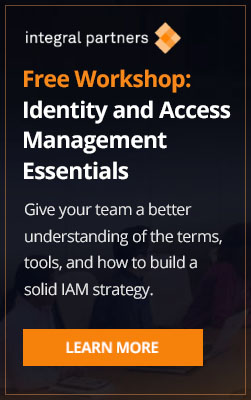Imagine you’re going on a roadtrip: chances are you’ll be using some kind of map or GPS to get there. Even when you know your destination — but especially if you’re going somewhere you’ve never been before — you’ll want to rely on directional data to get you where you need to go: tell you the fastest route, help you avoid toll roads, and ensure you take the right exits.
Now imagine you’re taking a similar approach to navigating identity and access management (IAM). Even organizations that create a roadmap and strategy often fail to revisit these plans down the road, to check whether they’re headed in the right direction. The result is that you become vulnerable to losing your way.
Roadmaps help you navigate when the road ahead is uncertain
When you can’t see around corners and the landscape is always changing, there’s a simple way to keep your IAM program on-track, reduce risk, and integrate new information: make it a point to periodically revisit your roadmap and strategy.
Integral Partners stays aware of what’s changed in the IAM landscape — the new roads, shortcuts, and signposts — so that you don’t have to. Because IAM is our speciality, we know how to update your plan with the right information to keep you on the fastest, safest route. Here’s how we help our clients do it.
Integral Partners treats roadmap and strategy check-ins as a kind of mini advisory project. This ensures that we’re giving your plans the thorough, comprehensive evaluation they deserve, and helps us best serve you by reviewing your plans with your updated goals, status, and input.
We’ll look closely at your organization’s current state (process, challenges, and drivers), and how you performed against your plans over the last few years. We’ll review what’s changed in available technology and consider the latest solutions, and map that against your ideal state (business objectives, budget, and industry trends). Then we’ll revise and update your roadmap to address the deltas and changes. Your original strategy may still be appropriate, in which case we’ll include guidance for how to get back on track; or, we might make new strategy recommendations if your technology or business environment has significantly changed.
If you’re due to revisit your roadmap and strategy, here are some important questions to ask.
- Are you tracking to your current roadmap? If not, why? Knowing this helps us understand your current status — where you are now — as well as the twists and turns you took to get here. With a better understanding of your past organizational behavior, we can help you better plan for the future.
- Are you implementing the fundamentals? Have you taken your roadmap’s recommended actions, in the right order, or have you gone rogue? For example, if you’re deploying tools but skipping policy, you may be setting yourself up for trouble down the road instead of building towards long-term success.
- Was the advice you were given appropriate, considering where you are now? When you developed your roadmap and strategy, you made decisions based on your situation and the technology and tools available at the time. Those decisions might still apply today, or they may no longer be appropriate.
- Has your business strategy changed? Your business strategy guides your IAM strategy, so if it’s undergone significant changes we’ll want to make sure your approach to identity is tracking to your new direction. Maybe you’re targeting new market sectors, or a merger or acquisition has changed your use cases, for example.
- What new features and trends are impacting your roadmap? Whether you’re implementing a cloud-first strategy, want to integrate AI, or need to accommodate a larger WFH workforce, your roadmap’s milestones and priorities may need to shift accordingly.
- Has your leadership changed? New leadership is a common driver for starting, suspending, or re-evaluating IAM strategy. If you’ve undergone a leadership change it’s relevant to ask whether your existing roadmap is still appropriate, given potential changes in focus.
- Do you have buy-in? The roadmap represents your technology environment implemented by your people on your cadence, and the strategy represents the “why” that drives it. One of the most important things we do in our advisory engagements is sit down with the client’s IT group and review the strategy and roadmap: their buy-in is what makes executing on strategy possible.
How to know when you’re due for a true-up
Companies that think of IAM as a software project with deployment as the destination might never have created a roadmap and a strategy, while others create these plans but then never look at them again. We get it; IT staff are busy keeping the lights on, leaders are heads-down running the business, and your roadmap and strategy can quickly become an afterthought. But if you don’t pick up your head and look around every once in a while, how do you know if you’re going in the right direction?
The cadence at which you should revisit your roadmap and strategy will depend on how you think you’re doing, but we believe the sweet spot is about every two years. So, are you on-target or behind with your current roadmap? Have you had a strategy assessment in the last few years? Are you deploying the recommended tools, and are they effective? If you don’t know the answers, it’s probably time for an update.
And if you don’t even have an IAM roadmap and strategy to revisit, we can help with that, too. Just contact us to get started.


Comments are closed.